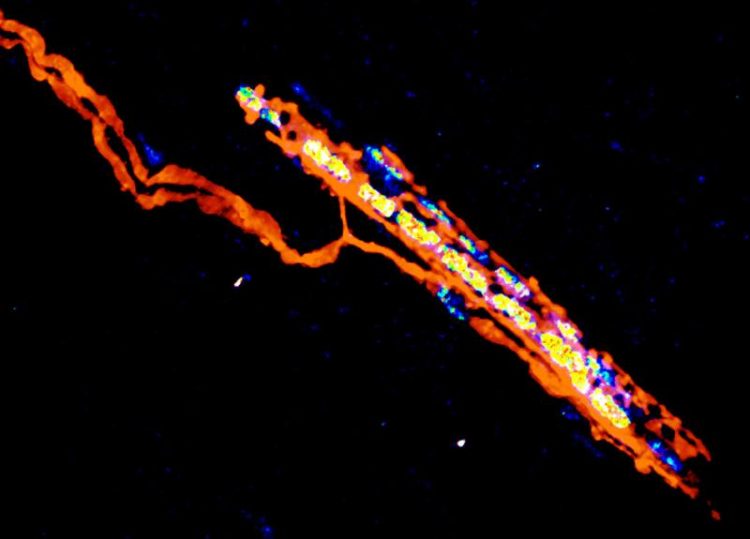Trigger mechanism for recovery after spinal cord injury revealed

Sensory nerve terminals (orange) of a muscle spindle. (Fig: University of Basel, Biozentrum)
This circuit-level mechanism behind the process of motor recovery was elucidated by Prof. Silvia Arber's research group at the Biozentrum, University of Basel and the Friedrich Miescher Institute for Biomedical Research. Their findings may contribute to designing novel strategies for treatment after spinal cord injuries and have now been published in the journal Cell.
Spinal cord injuries often lead to chronically impaired motor function. However, patients with incomplete spinal cord injury can partially regain their basic motor ability under certain circumstances. It is believed that remaining uninjured spinal cord tissue provides a substrate to form new circuits bridging the injury. How this formation of new connections is triggered and promoted has remained unclear until now.
In collaboration with Prof. Grégoire Courtine's research group at the EPFL in Lausanne, the team of Prof. Silvia Arber at the Biozentrum at the University of Basel and the Friedrich Miescher Institute for Biomedical Research (FMI) has demonstrated in a mouse model why paralyzed limbs can move again after incomplete spinal cord injuries: A specific sensory feedback channel connected to sensors embedded within the muscles – so-called muscle spindles – promotes the functional recovery of the damaged neuronal circuits in the spinal cord.
Muscle spindle sensory feedback provides trigger signal for recovery
Limb movement activates sensory feedback loops from the muscle to the spinal cord. This specific feedback channel promotes the repair process of the damaged spinal network after injury. As a result, basic motor function can be restored. “The sensory feedback loops from muscle spindles are therefore a key factor in the recovery process,” says Silvia Arber. After spinal cord injury, these nerve impulses keep providing information to the central nervous system – even when the transmission of information from the brain to the spinal cord no longer functions.
“An important trigger for the recovery process is the information conveyed from the muscle to the central nervous system and not only the top-down information the brain sends towards muscles,” explains the first author Aya Takeoka. In addition, the researchers demonstrated that only basic locomotor functionality could be restored spontaneously after an injury. Fine locomotor task performance tested, however, remained permanently lost.
Treatments must start with activation of muscle spindles
The study suggests that activation of muscle spindles is essential to promote the recovery process of damaged neuronal networks after spinal cord injury. Thus, therapeutic approaches should aim to extensively use the muscles, even if passively after an injury. The more intensely muscles are used in the movement process, the more muscle spindle feedback circuits are stimulated. By applying this principle, the repair of neuronal circuits and the accompanying recovery of basic motor skills will have the best chances of succeeding.
Info box: The muscle spindle
Muscle spindles are sensors in the skeletal muscles of the body, which are passively stretched or shortened by muscle expansion and contraction. Each of these muscle spindles, localized within a muscle, is contacted by sensory nerves. Sensory information is conveyed by these neurons directly from the muscles (e.g. from the arms or legs) back to the spinal cord. These transmitted impulses allow us, for example, to determine with closed eyes in which position our arms, legs, hands, and fingers are. In other words, to know where our whole body is positioned.
Original citation
Aya Takeoka, Isabel Vollenweider, Grégoire Courtine, and Silvia Arber
Muscle Spindle Feedback Directs Locomotor Recovery and Circuit Reorganization after Spinal Cord Injury
Cell (2014)
Further Information
• Prof. Dr. Silvia Arber, University of Basel, Biozentrum, phone: +41 61 267 20 57, email: silvia.arber@unibas.ch
• Heike Sacher, University of Basel, Biozentrum, Communications, phone: +41 61 267 14 49, E-Mail: heike.sacher@unibas.ch
Media Contact
All latest news from the category: Life Sciences and Chemistry
Articles and reports from the Life Sciences and chemistry area deal with applied and basic research into modern biology, chemistry and human medicine.
Valuable information can be found on a range of life sciences fields including bacteriology, biochemistry, bionics, bioinformatics, biophysics, biotechnology, genetics, geobotany, human biology, marine biology, microbiology, molecular biology, cellular biology, zoology, bioinorganic chemistry, microchemistry and environmental chemistry.
Newest articles

High-energy-density aqueous battery based on halogen multi-electron transfer
Traditional non-aqueous lithium-ion batteries have a high energy density, but their safety is compromised due to the flammable organic electrolytes they utilize. Aqueous batteries use water as the solvent for…

First-ever combined heart pump and pig kidney transplant
…gives new hope to patient with terminal illness. Surgeons at NYU Langone Health performed the first-ever combined mechanical heart pump and gene-edited pig kidney transplant surgery in a 54-year-old woman…

Biophysics: Testing how well biomarkers work
LMU researchers have developed a method to determine how reliably target proteins can be labeled using super-resolution fluorescence microscopy. Modern microscopy techniques make it possible to examine the inner workings…





















